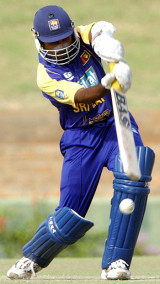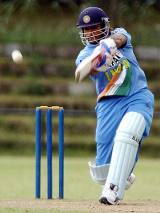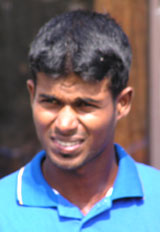
|

Mahela Jayawardene practises at Dambulla ahead of the Indian Oil Cup
© Getty Images
|
|
At first glance, the Indian Oil Cup may appear an irrelevance in comparison
to the last India-Pakistan face-off or the (what we thought might be)
classic 2005 Ashes contest underway in England. For starters, there will be
no Sachin Tendulkar and no Brian Lara. Worse, because of the West Indies
player dispute, barring a sudden and miraculous flowering of batting talent,
there will be little competition. The first six 'group' matches will lead to
one sadly inevitable knockout and then Sri Lanka and India will play their
82nd match against each other in the final. The winner of the toss will bat
first and then, according to the statistics, have a 75% chance of carrying
away a trophy that will gather dust in a cricket board storeroom. The
organisers have even denied us the innovation of Super Subs and Power Plays because the tournament starts 48 hours before the rules become mandatory: but perhaps that's wise considering their now-obvious flaws.
Dig a little deeper and you can, thankfully, shelve some your
cynicism. India's arrival in Dambulla, a central town famous for its
Buddhist Cave temples and bustling vegetable markets, has been accompanied by a
huge India media contingent. Journalists, commentators, photographers and TV
interviewers have helped fill up the hotels and will leave the press box
overflowing. They are travelling because
this Indian Oil Cup, for its likely predictability, marks the start of a
20-month road to the 2007 World Cup. Moreover, for both India and Sri Lanka,
it heralds the beginning of new eras under their new high-profile Australian
coaches, Greg Chappell and Tom Moody.
For several months this year we all witnessed one of the most publicised and
farcical processes in the history of recruiting cricket coaches. While
India and Sri Lanka's players put their feet up for a well-deserved rest,
the administrators swung into the limelight with considerable pomposity
to find replacements for John Wright and John Dyson. Both boards shortlisted the same men; happily, after a host of headline-grabbing
interviews in June, both got the man they wanted most. After all the press
conferences and interviews and news-bites the action starts for real and
people in both countries are anxious to know whether their new man has got
what it takes to turn their team into world champions.
The Indian Oil Cup could provide fascinating insights into each team's new
direction: will Sri Lanka shuffle around the batting order? Will Moody
discover the seam bowling allrounder that Sri Lanka coaches have been praying for
over the last five years? Will India's new star, MS Dhoni, open the batting in
Tendulkar's absence, forming an explosive alliance with Virender Sehwag - or
will VVS Laxman be used as a steadying influence up top? Will Chappell's
tenure herald an era of greater flexibility with the batting? Will India
stop losing finals? Will Chappell insist his players drink Soya milk for
breakfast? Answers to these questions, and a few more besides, are eagerly awaited.
For India, there are other matters of significance, the most important of
which is the future of their captain, Sourav Ganguly. His team's slow over-rates during the Pakistan series could have the severest consequences,
speeding up his exit from the leadership and, conceivably for all those not
living in Kolkata, even the one-day team. The Indian cricket board failed in their renewed appeal to quash his ICC ban. Ganguly will now miss at least India's first two matches
and that means handing over the reins to Rahul Dravid, the heir apparent, and, more dangerously, giving one of India's young guns his place in the batting order.
Ganguly has clearly played an instrumental part in India's rising fortunes
this decade. His sharp mind, passion and steely determination have rubbed
off on his players. With John Wright organising, encouraging and polishing
in the background, Ganguly has lifted the team upwards and made them a
serious force in international cricket. No longer can they be ridiculed for
being soft-bellied and weak-kneed abroad. They are stronger, tougher and
even more crazily idolised by their fans back home. But every journey has an
ending and Ganguly, now 33, appears to have reached a crucial juncture in
his career. His batting form has dipped and, unless he can bounce back soon,
then his place in the side may become unjustifiable.
Chappell has backed the captain to return, but he's also been looking ahead:
"If we can put the building blocks in place here [Sri Lanka] to build some
success over the next couple of years then we will put ourselves in a better
position come 2007," he told reporters on Thursday. And in the absence of
Ganguly and Tendulkar his mantra is "flexibility". "The more flexibility you
have the more options you have available to you under all circumstances. We
are in a situation now where we have two key players out and if you don't
have flexibility you run into problems. If we can build a squad that is
15-20 strong then we will have a lot less problems when we have key players
out of form or out of action."

|

MS Dhoni: thrill-seekers will be keen for him to be included © Getty Images
|
|
India are being so flexible that everyone is still guessing about their
batting line-up. Thrill-seekers are desperate to see Dhoni given the nod as
Sehwag's opening partner. Old wags in the press corps, though, predict
Laxman to be called up as an interim opener. The presence of Yuvraj Singh at
No. 3 in both practice games has also caused a stir, but Chappell merely
stands in front of the cameras and says "we are looking at all options" and
"nothing has been decided".
Ganguly's counterpart, Marvan Atapattu, has no such problems. Although
Atapattu's natural accession to the full captaincy after the resignation of
Sanath Jayasuriya in 2003 was surprisingly delayed, slowed by shadowy but
powerful detractors within the establishment, he has now cemented his
leadership at least until the 2007 World Cup. If Arjuna Ranatunga's
leadership was dictatorial and Jayasuriya's consensual, Atapattu's style
fits somewhere in between, being both strong and egalitarian. Atapattu has
brushed away the last vestiges of feudalism within the dressing-room and
communicates his expectations clearly. On the field, unlike Jayasuriya, he
remains calm, relaxed and in control.
The result is a happy and settled squad anxious to start a long year on a
successful note. During the last nine months they have played
just one ODI, a game in New Zealand that was swiftly followed by tragedy on
an unprecedented scale. The Asian tsunami forced the cancellation of that
tour and then a short ODI tour to India was axed, in part owing to the cricket board crisis in March, when the government launched a takeover of the cricket administration. A Mickey Mouse tournament was
held in Abu Dhabi and a few of the players have been involved in
tsunami-related charity matches or county cricket, but most have played
precious little. The break from non-stop touring will leave the players,
like the Indians, a little ring-rusty but at least they should be refreshed
and ready for the action-packed year ahead.
During the Indian Oil Cup Atapattu and Moody will hopefully unveil some
clues to their early World Cup thinking but, in truth, few great changes are
anticipated. Sri Lanka already have a mightily effective formula for winning
matches on slow subcontinental pitches, a strategy that revolves around
their top order piling up runs and their spinners, the specialists and the
part-timers, slowly strangling the run chase. The team is vastly experienced
and there are not many places up for grabs before the 2007 World Cup. The
main issues to be resolved are the batting order, especially the openers and
the identity of the allrounders.
The selectors have made significant changes at the top, axing
Avishka Gunawardene and Saman Jayantha, good-but-not-great batsmen that have
been rotated in-and-out during the past few years. Both have been given
chances, but have positively influenced or won too few matches as Jayasuriya's opening partner, especially overseas. Yet, in ODIs, the top four
positions in the order are prime real estate, offering quality batters the
best opportunity of playing themselves in and positively influencing the
outcome of the match. Sri Lanka, though, have for far too long been wasting
precious overs on run-of-the-mill openers.
Moody has identified Jayasuriya's partner as an urgent issue: "We need to
develop some stability at the top of the order," he told Cricinfo. "In the
past couple of years we have had a lot of players occupying that opening
position and I would like to think that with time we could get some
stability there. I don't want to shake-up the order as it has been a
successful formula, but the opening position has been a revolving door - I
would like to close it so we all know what roles we are playing."

|

Upul Tharanga: chance to make a name for himself
© Getty Images
|
|
Upul Tharanga, a 20-year-old, has been given the opportunity to stake his
claim during the tournament. Marvan Atapattu has made it clear that he likes
the balance created by him at No 3 and also someone with the quality and
experience of Mahela Jayawardene at No 5 in the middle order. This rules out
the option of Sri Lanka reverting to their Test line-up in ODIs. So
Tharanga, a left-hander with sweet timing, is set to open throughout the
tournament.
Moody is also keen, like Dav Whatmore and John Dyson before him, to find the
elusive seam-bowling allrounder that will balance the team. "I would like to
think that we can produce a world class seam bowling allrounder; an
allrounder that can be relied on with bat and ball. It is good to have
spinning allrounders in the sub-continent but they are not the players that
win or influence matches as much as seam-bowling allrounders outside the
subcontinent."
Sadly, for non-cricketing reasons, West Indies are the firm underdogs. A
ridiculous and sad sponsorship dispute - an obvious problem that should have
been identified well before the signing away of exclusive player image
rights to Digicel by the West Indies Cricket Board - has led to 10 leading
players refusing to sign tour contracts, meaning a whole raft of freshers
have been polevaulted into the senior team. The result is a West Indies team
that contains some promising bowlers, but a crippling shortage of batting
talent. Unless Shivnarine Chanderpaul, their captain, stars in each and
every outing their qualification to the final is inconceivable.
Hopefully, in a game that is famous for its glorious uncertainties, they can
defy the predictions of cynical pundits. Certainly, the Indian Oil Cup needs
them to rise to the occasion. All the intrigue about the new Chappell and
Moody regimes will only be able to sustain our interest so long.
Charlie Austin is Cricinfo's Sri Lankan correspondent





